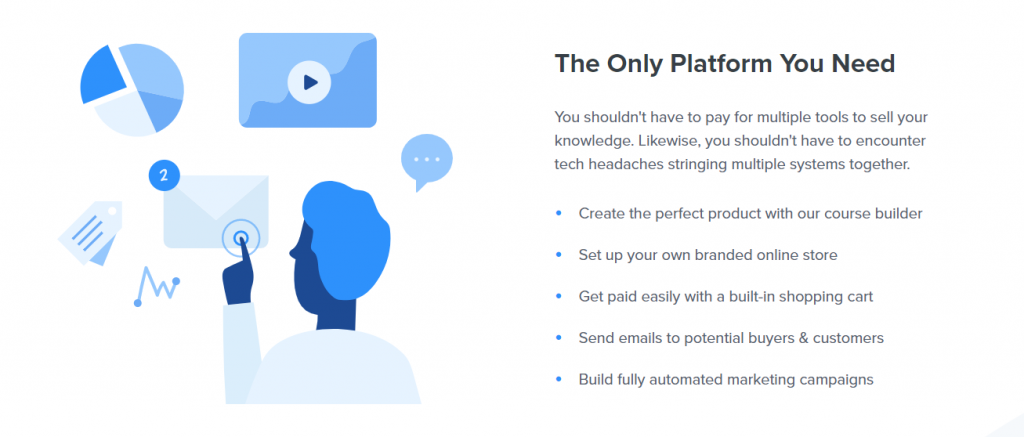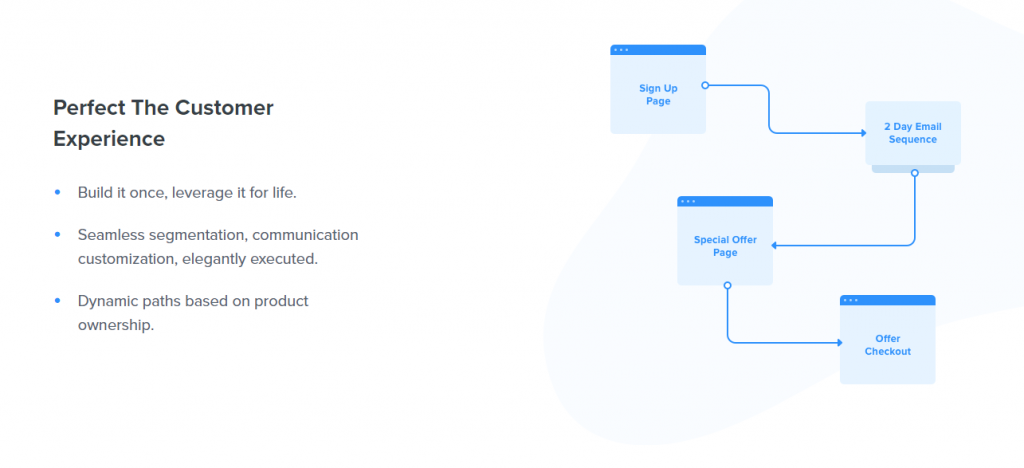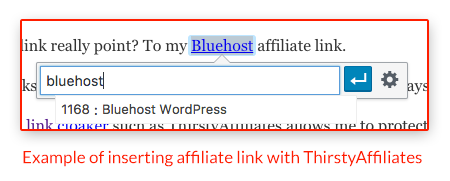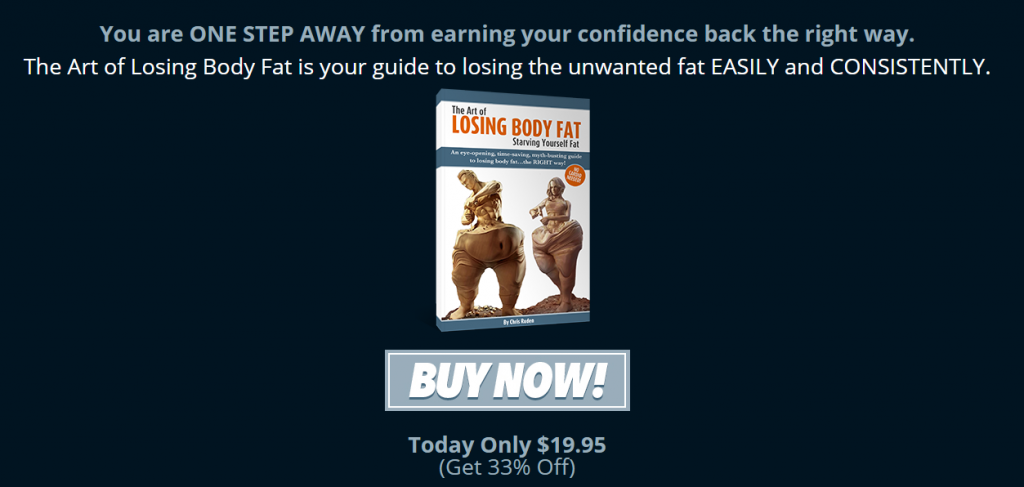Do they say that knowledge is power, but is that really true? For content marketers, knowledge is only powerful if it can be converted into a product, a service, sales, and a bottom line.
So how do you turn content into a money-making machine?
That’s the million-dollar question.
Here are five different ways to convert your know-how into a viable business, and some of the best tools to use for each one.
Table of Contents:
1. Create an online course
The obvious advantage of teaching a course online is that you only have to record it once, and then you can sell it to as many students as you like. It saves hours of time, and it’s a really efficient way to make money from your content.
Another advantage is that you can create a community of students, and keep upgrading your course or creating subsequent courses. You will already have a group of customers ready to buy.
It’s predicted that by 2019, 50% of all students in the US will be taking courses online. So there’s quite a huge demand for online learning and you don’t want to miss it.
There are many tools and platforms that you can use to create your online course. If you are looking for something comprehensive, you can use a tool like Kajabi.
It’s a platform that allows you to create a course, host it, set up recurring payments, and grow your email list with marketing automation.
It literally has everything you need from A to Z.

You can set up email marketing campaigns and segment your list. You can also create landing pages and email popups to grow your list. And the best part is their marketing automation features, where you can literally target specific customers based on where they are in the customer journey.

If you don’t already have an extensive network, then your best bet is to host your course on a popular learning platform like Udemy or Skillshare.
The fear that most online course makers face is how to get those first customers. A great way to solve that issue is to offer the course for free in the beginning and ask all your students for a review.
When you gather enough reviews, you can start charging for the course, and people will flock to it because of the social proof.
Another strategy that was popularized by Skillshare is to make mini-courses, each on a specific skill or project. Instructors like Brian Peters, the digital marketing strategist at Buffer, have done exactly that. He has one course on social media strategy, and another on social media advertising.
While each platform has its unique advantages, it’s always a good idea to sell an online course. It’s a great way to save time and create a new form of passive income for your business.Tools to use:
Udemy – This is by far the most popular online learning platform. Use it to offer your course, interact with your students, and create follow-up courses. It’s free to use.
Free.
Skillshare – What’s great about Skillshare is that it’s designed for smaller courses that are centered around one particular topic, a project, or a skill. So you can create more courses, and get paid for them. You get paid for each minute that your students spend watching the class. So it’s a little bit more unique and flexible.
Free.
Kajabi – A really great platform to use to create, promote, and analyze your online courses. This platform really does it all for you.
Pricing –
- $129/month (5 products, 25,000 emails/month, 1,000 active members)
- $389/month (100 products, 75,000 emails/month, 10,000 active users, 3 sites)
- $899/month (unlimited products, 150,000 emails/month, unlimited active members, 10 sites)
2. Affiliate marketing
Affiliate marketing was a very hot topic in 2017, and it’s definitely going to become even more relevant in 2018.
Affiliate marketing is a great way to promote products or services by linking to them in your content. It’s a way to get passive income that increases over time.
One brilliant example of a successful affiliate marketing strategy is the website, Wirecutter, which was purchased by The New York Times for $30 million in 2016. Its total affiliate revenue surpassed $150 million in 2015.
The key is to grow your affiliate marketing efforts organically. Use only those products or services that your audience will appreciate, and talk about them naturally, without overselling them.
Don’t structure your entire strategy around your affiliate income – definitely still focus on pumping out good quality and highly engaging content.
If you’re using WordPress for your website or blog, you should use an affiliate plugin like Thirsty Affiliates. It will help you insert your affiliate links and keep track of all of them. It will also help you cloak them so that hackers won’t hijack your commissions.

Tools to use:
Thirsty Affiliates – This is a great WordPress plugin that helps you hide your affiliate urls behind redirect links (protecting you from theft). And it helps you insert them into your blog posts easily. It also helps you track broken links, and generate analytics report for each link.
Pricing –
- $49/year (1 site)
- $79/year (5 sites)
- $149/year (unlimited sites).
Linktrack – A free link tracking tool that helps you keep track and manage all of your affiliate links. It has super easy to read graphs that display all your links and all the clicks and visits that you generated.
Free.
Clickmeter – Use this link tracker if you need something a bit more sophisticated. It has A/B testing features, can handle multiple domains, and provides over 100 features.
Pricing –
- $29/month (25k events/month and 2,500 data points)
- $99/month (200k events/month, 20k data points)
- $349/month (2M events/month and 200k data points)
3. Freelance writing
Freelance is the most popular way to make money from your content because the barriers to entry are so low. Anyone can pick up some marketing chops and start offering their services on Fiverr or Guru.
If you want to become an expert freelancer, you need to take some steps to establish yourself online and put some processes in place to get found.
Here are some quick tips that you should follow:
- Create a website so you have your own domain that online publishers can link to.
- Make sure to post content on it regularly (weekly or bi-weekly at a minimum).
- Aggressively use social media (Facebook, Twitter, Instagram, and LinkedIn) to build an online community and to promote the content that you write.
- Use a tool like ClearVoice to create a portfolio of all your articles, and send it out to potential clients.
- Use a LinkedIn tool like LinkedHelper to automatically connect with 50 people a day and expand your potential clientele.
Tools to use:
ClearVoice – It’s a free platform that you can use to assemble a portfolio of your work and find writing jobs of all kinds (landing pages, ebooks, pdf guides, and articles).
Free.
LinkedHelper – Brilliant LinkedIn tool that helps you send out 50 connect messages per day, get endorsements and recommendations, and invite all of your connections to your LinkedIn group.
$15/month.
StatusBrew – A great tool to use to grow your Twitter audience, increase engagements, monitor your brand, and automate your publishing.
Pricing –
- Free (1 account)
- $20 (10 accounts, publishing + growth tools)
- $40 (10 accounts, publishing + listening + growth tools + team management)
Fiverr – Probably the best platform to get specific gigs as a freelancer. Just pick a category, write up a quick description for your gig, and you are ready to start selling.
Free.
Guru – This platform is more geared towards virtual assistants and consultants. Use it if you want to build a portfolio and a long-term career in freelancing.
Free.
Looking for a professional invoice generator? Create your invoices with our easy-to-use generator.
4. Blogs and newsletters
Blogging is a great way to build an online audience, create really valuable content, and sell a bunch of different goods or services. You can monetize a lot with blogging and email.
For one, you can promote relevant products and get an affiliate income out of that, as discussed above.
The master marketer Tim Ferris, author of the 4 Hour Work Week, promotes products on his weekly “5 Bullet Friday” email blast, in which he mentions each product very organically.
It looks like he tried and tasted every single protein powder and energy enhancer that he promotes, and it makes for a very convincing ad. It’s so good you even forget that it’s an ad, it just looks like a friend recommending something they genuinely enjoyed.

Another great way to monetize your blog is to create an exclusive community for it that your readers have to pay for to join. You can also create exclusive content that can only be unlocked if you are a member.
Tools to use:
WordPress – The best place to build your blog. It’s free, easy to use, and you can find a ton of developers that are experts in it if you need some work done.
Free.
Unsplash – Best place to go for free images and stock photos. Yes, seriously, you don’t have to pay for anything.
Free.
Canva – Free tool that you can use to create graphics of all kinds. For blogging specifically you can use Canva to create blog banners, social media banners, headers, and infographics.
Free.
Snappa – The best tool for blog header images. It’s absolutely incredible and offers a free version as well.
Pricing –
- Free (5 downloads per month)
- $15/month (1 user & unlimited downloads)
- $30 (5 users & unlimited downloads)
5. Influencer marketing
What if you don’t have a serious social media reach or an engaged online audience of followers? How can you sell your product? The answer is by using influencers.
Influencers are people with a large number of followers (anywhere between 1k and 5M+) who work with brands to promote their products and services.
The reason influencers are so effective is because people trust the opinion or recommendation of their peers much more when making a buying decision then traditional advertising.
According to Collective Bias, 60% of consumers look to posts and reviews on social media to decide on product,s as compared with 7.4% for TV ads, 4.5% for digital ads, and 4.7% for print media.
What if the consumer doesn’t know the influencer or the person making the recommendation?
Nielsen did a study where they found that 92% of online consumers trust brand recommendations that they get from people they don’t know.
One example is the campaign that Microsoft did with National Geographic for International Women’s Day. They hired a team of female adventure photographers to create 30 photos around famous female explorers using the hashtag #MakeWhatsNext.
They were able to get 3.5 million likes in one day (that’s over 115k likes per post), and reach over 91 million people.

Clearly, social media has become about 10 times more powerful than TV, and that gap is going to increase more and more.
What’s the advantage for the brand?
According to a study conducted by eMarketer, brands saw an average ROI of $6.85 for every dollar that they spent on influencer marketing.
This is why it’s a fantastic idea to jump on the influencer marketing bandwagon while it’s still underpriced.
6. Ebook creation
Another great way to turn your knowledge into earnings is to create ebooks. And it’s actually much easier to find material for an ebook than you might think.
Here are a few simple ways:
- Turn several of your best blog posts into one ebook.
- Turn a long guide from one of your posts into an ebook.
- Dictate and turn your voice notes into an ebook.
Take Chris Ruden for example. He started a blog on losing weight and powerlifting and picked up a few clients.
Once he saw that he was transforming people’s lives through his content, he decided to create an ebook called The Art of Losing Body Fat. He sells it for $19.95 on his own site, and with no printing or publishing costs he is making a hefty profit.

Tools to use:
Pressbooks – This is a WordPress plugin that allows you to easily create, edit, and design your own ebook. The best part is that you can collaborate with your team and work on it together.
Pricing –
- $19.99 one-time fee per book
- $99 one-time fee per book (with some more format options)
Podia – This is a platform that is similar to Patreon but is specifically geared for selling online products. They have a really simple drag-and-drop interface that allows you to drag your ebook or online course, set a price, and start selling!
Pricing –
- $39/month
- $79/month (use this plan if you want to sell memberships)
Beacon – This is another WordPress plugin that helps you create an eBook by automatically converting your blog posts into one. It uses HTML5 or PDF formats.
Free.
iBooks Author – This is software that’s built for iBooks. It helps you design and create iBooks for iPad, iPhone, and Mac. It has incredible templates to choose from and a drag-and-drop interface.
Free.

Recap
There are a number of ways that you can use your knowledge and skill set to create products and revenue streams for your business.
Here are the top 5 ways that I covered:
1. Online Courses
2. Affiliate marketing
3. Freelancing
4. Blogging
5. Influencer marketing
6. Ebook Creation
Did I miss anything from the list? Have anything to add? Leave a comment below.






